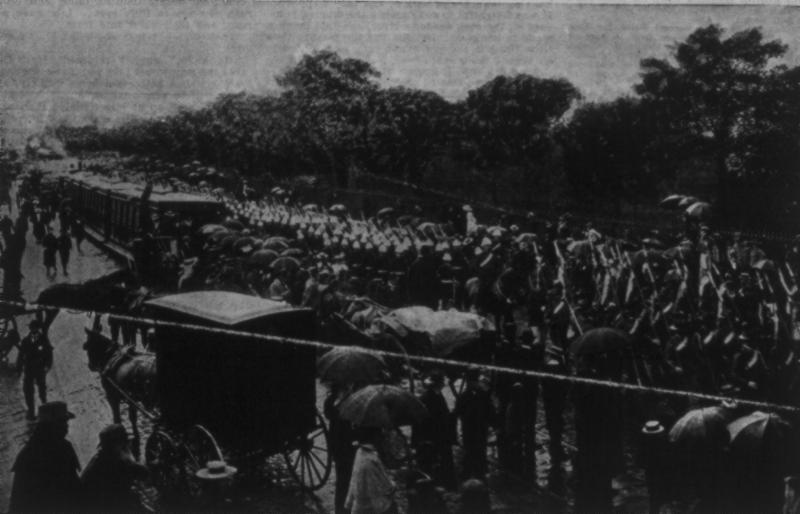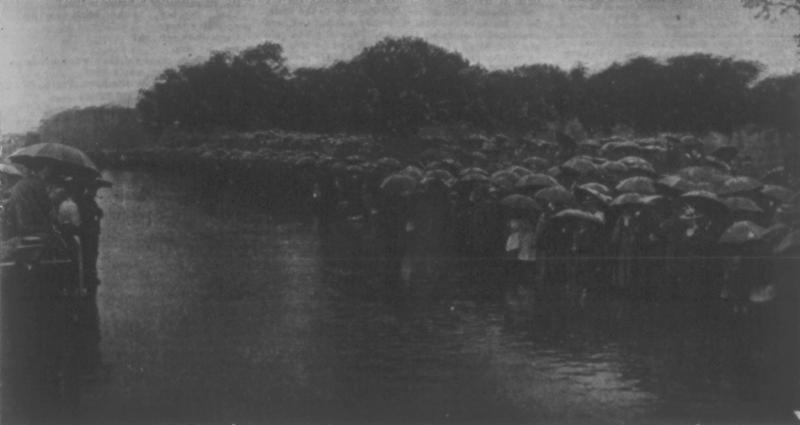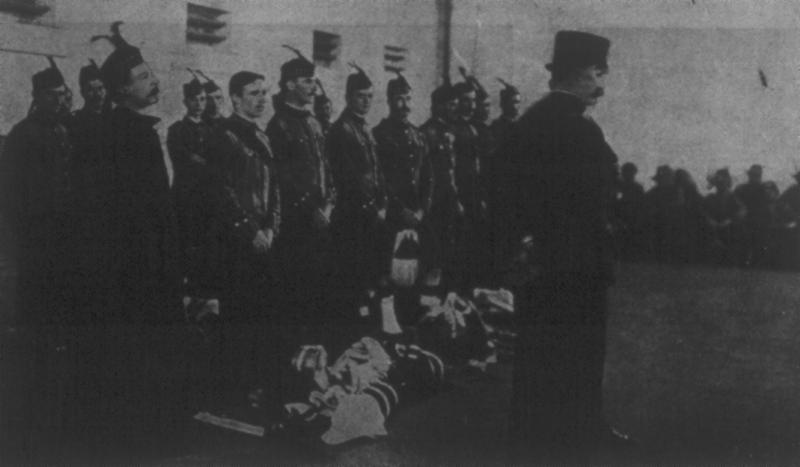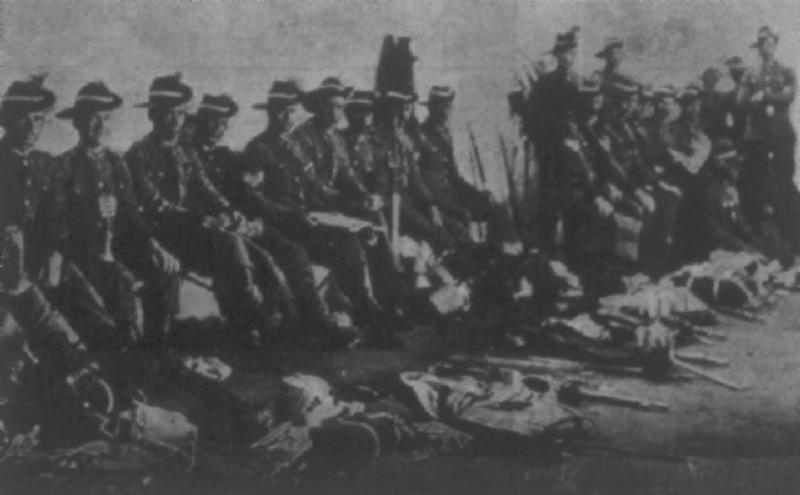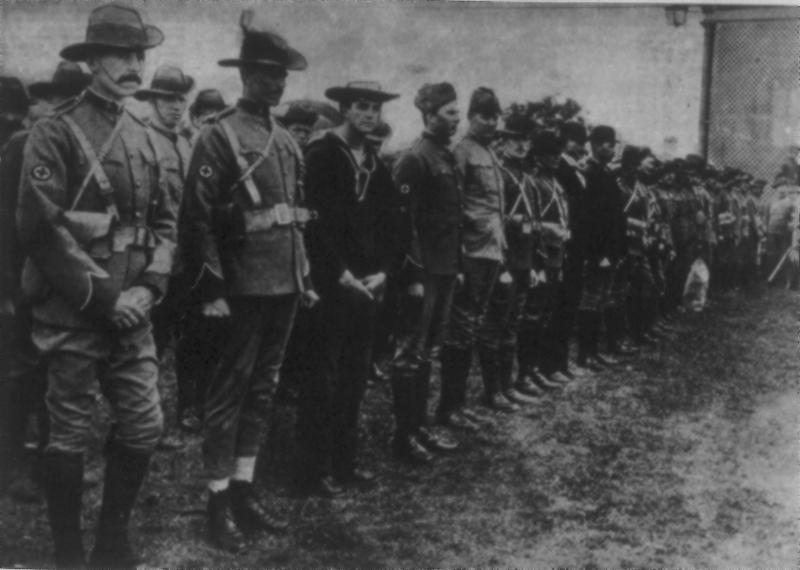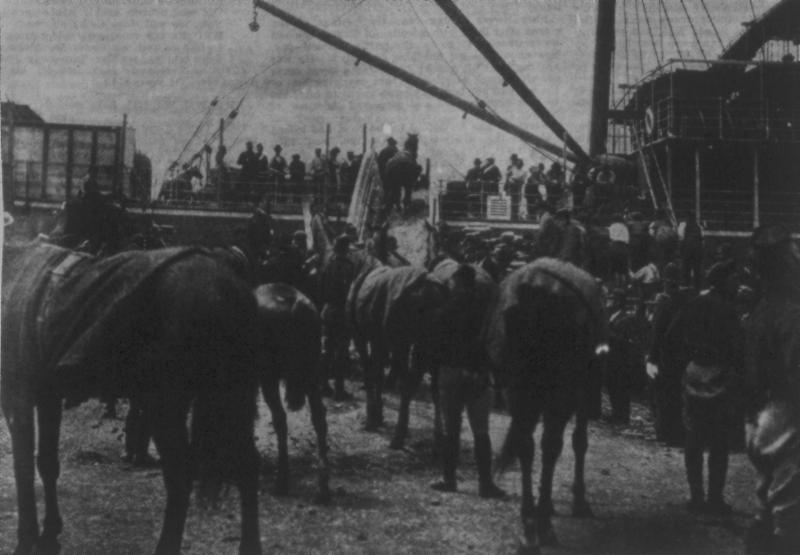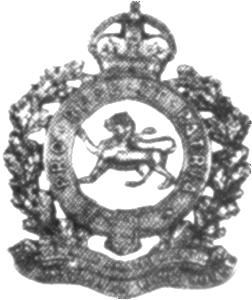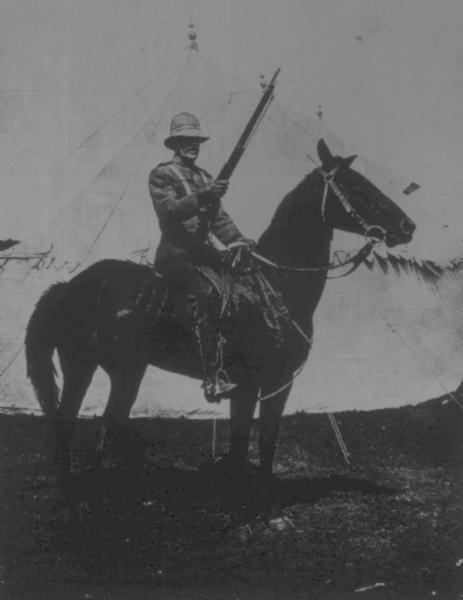Topic: BW - Boer War
Australian Contingents for South Africa
1899
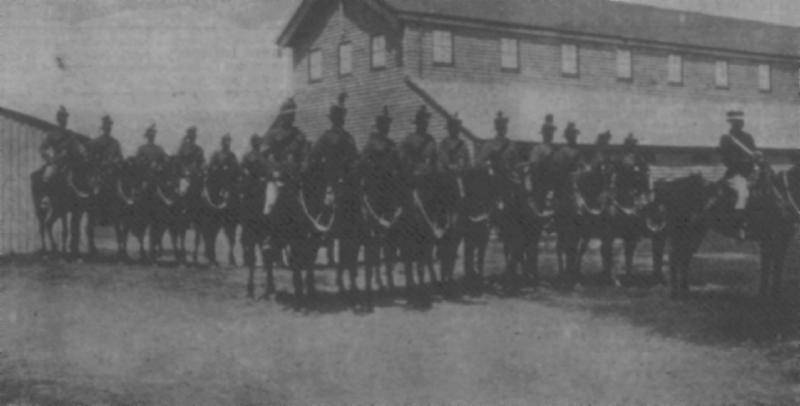
[From: Town and Country Journal, 28 October 1899, p. 39.]
The following is an extract from the newspaper Town and Country Journal, 28 October 1899, p. 14.
THE ARRANGEMENTS FOR EMBARKATIONS
All arrangements are therefore being pushed forward, with a view to getting the men away at the end of the month.
Major-General French, who is still suffering from the effects of an attack of Influenza, was very busy on Saturday in consultation with his staff, and was also seen by the Premier and Mr. See, Minister for Defence. Afterwards our representative was favoured with an interview with Colonel. Mackenzie, the A.A.G., and was informed that It had been definitely decided to send the following men:
One unit (125 men) of Infantry; one unit (125 men) of Mounted Rifles; one-half bearer company; one-half field hospital. It has not yet been decided whether the additional Lancers, to bring up the strength of the squadron to 125, will be sent or not. At present their strength is about 90 men. Rates of pay are to be as follow:
|
| Rates of Pay per day divided as | Per Day | Deferred Pay |
| Privates | 4/6 | 2/3 | 2/3 |
| Corporals | 7/- | 4/9 | 2/3 |
| Sergeants | 8/- | 6/9 | 2/3 |
| Company sergeant-majors | 9/- | 6/3 | 2/9 |
| Staff sergeants | 10/- | 6/6 | 3/6 |
| Warrant officers | 11/6 | 7/6 | 4/- |
|
|
| Per day | Field Allowance |
| Lieutenants | 19/- | 16/- | 3/- |
| Captains | 23/6 | 20/- | 3/6 |
THE N.S.W. ARMY MEDICAL CORPS.
In view of the acceptance by the Imperial authorities of a unit of the New South Wales Army Medical' Corps for service with the imperial forces in South Africa, and the passing of the vote of £30,000 in Parliament, the history and description of the work done by the corps may be of interest. Colonel Williams, P.M.O., commanding military services at the Victoria Barracks, furnished our representatives with the following particulars:
"In 1886," said the Colonel, "when the Soudan Contingent from this colony was organised, no medical service for duty with the troops in the field was in existence in New South Wales however, to meet the requirements of the contingent, a small corps was specially organised by myself, an I was the principal medical officer of the contingent, the corps being equipped as well as the circumstances and means at my disposal permitted.
This extemporised ambulance corps of forty of all' ranks was the starting point of the present medical services of New South Wales, for in 1887 submitted a scheme for the formation; of a corps, on partially paid lines, which was known as the Medical Staff Corps. In 1891 a small permanent section of ten non-commissioned officers and men were added, to carry out the daily routine of the Garrison Hospital Ambulance Depot and general duties. In 1898 the title Medical Staff Corps was abolished by Royal warrant, and that of the Royal Army Medical Corps substituted in the Imperial service. New South Wales and Queensland have followed on the same lines; naturally, however, omitting the word 'Royal'. The organisation and present establishment of the New South Wales Army Medical Corps is as follows:- Colonel Williams, P.M.O., and officer commanding medical services; (a) permanent section, consisting of 4 N.C.O.'s and 5 privates; (b) partially-paid establishment, two companies, A and B, under the command of Lieutenant-Colonel Vandeleur Kelly, who has with him Captains Green and Roth and Lieutenants Martin and Hall. Lieutenant Beauman fills the position of quartermaster, and Warrant-officer Bond is the regimental sergeant-major and staff instructor. In addition to these there is a medical officer on the P.P. establishment attached to B and C Batteries, N.S.W. Field Artillery; to the N.S.W. Artillery Regiment, and to 1, 2, 3, and 4 Regiments of Infantry."
Colonel Williams also furnished the following additional information: The volunteer establishment consists of officers only, who are principally resident in the country districts where they are attached, doing duty with the military unit of their district. These officers are some 36 in number, and have done, and are still doing, remarkably good work. The Reservists, formed with a view of being able to bring the peace establishment of the medical services up to war footing, are required to have a recognised ambulance certificate in "first aid," and to qualify in field ambulance duties, putting in a certain number of drills every year. They do not receive pay, but are provided with a serviceable "khaki" uniform. This movement has proved a great success, and promises to become more popular. The Army Nursing Service Reserve is a lately-formed unit, organised on the lines of the Army Nursing Service Reserve of the Imperial Service, and numbers 26. The lady superintendent is Miss Gould, a member of the Royal British Nursing Association; and the superintendent, Miss Bligh Johnston, senior nurse at Sydney Hospital. The necessary qualifications for admission to this nursing reserve are of the highest order, none but nurses with nursing certificates of at least three years' training in large civil hospitals being eligible. A distinctive uniform for the Army Nursing Service Reserve has been adopted, and will shortly be issued.
The following is a short description of the duties of the various divisions of the Medical Service: The principal medical officer (who is the only permanently employed officer) Is responsible for the drill, discipline, training, and efficiency of the medical services of the colony, medical examination of recruits, the sanitary and statistical subjects, the supply of medical stores, and the administration of the medical services of the military forces of the colony. Lieutenant-colonel Kelly and the officers of the partially-paid corps carry out the training of the companies under their command, with the various ambulance drills and Sell exercises, and are to be congratulated on the present state of efficiency of the corps. These officers are slag available for departmental duties. The officers attached to regiments conduct the medical examination of recruits. for their individual regiments, the training of the regimental stretcher-bearers, and also attend with their regiment at continuous training, district camps, and, any parades as ordered. The special training of the army nursing service reserve is to be so based as to afford every opportunity of acquiring a knowledge of the special duties and routine as laid down for the conduct of military hospitals In the case of any war threatening the colony the services of these ladies would be invaluable. The ambulance depot at Victoria Barracks shows ambulances, transport-carts, harness, and all medical and surgical field equipment ready for issue and immediate service; and as Imperial patterns have been adopted throughout, no contusion can possibly arise when "on service" conditions with the Army Medical, Corps of the Imperial service.
These particulars will show why, as asserted by Colonel William, the Corps can be rear to the front at a very short notice.
The Army Medical Staff Corps will probably be armed, prior to proceeding to the smut, with .303 carbines in lieu of the swords which they at present carry. It is not yet known whether the carbines will be handed out before their departure from New South Wales or by the Imperial author ties on the arrival of the corps in South Africa. It is suggested that each man should be provided with fifty rounds of ammunition, to be carried in a bandoleer fixed to the tunic.
PREPARING THE MEDICAL CORPS.
The headquarters of the Army Medical Corps, at the rear o the Garrison Hospital, in the Victoria Barracks, were very busy on Tuesday. Lieutenant-colonel Vandeleur Kelly and Captain Roth were still engaged in the medical examination, of the volunteers, and, despite the repeated announcement that none but trained men would be accepted numbers of men presented themselves far examination who had never seen service in any form. The officers, however, quickly found out these men apparently by the way in which they began to divest themselves of their clothing, and they were speedily shown the door.
The Army Medical Corps contingent will consist of 87 officers and men, made up as follows:
Half-bearer Company: One captain, one lieutenant, one warrant officer, one quartermaster sergeant, one compounder, two sergeants, one corporal, one trumpeter, two privates as cooks, sixteen privates as bearers, and two privates as servants, with a transport brigade of , one sergeant, one collar maker, one shoeing smith, three, waggon corporals, one trumpeter, two privates as waggon orderlies, and sixteen privates as drivers - a total of 54 men. The Field Hospital will have a total strength of 33 officers and men, viz., two captains, one lieutenant, one ward master, one steward, one compounder, one corporal as each storekeeper, and one as clerk, six privates as ward orderlies, one private as cook, one private as pack storekeeper, one private as washerman, three privates an servants; with a transport brigade of one sergeant, one corporal, one shoeing and carriage smith, and nine privates as drivers. The equipment, which includes a field hospital of fifty beds, consists of five ambulance wagons, six transport carts, one water cart, three Maltese carts, fifty-eight horses, with beds, bedding, stores, drugs, tents, men's kits and accessories. The total weight of the equipment exclusive of waggons and carts, is about six tons.
The names of the following officers and non-commissioned officers have been submitted to the Government for approval by the P.M.O., Colonel Williams; Captains Fiaschi, Green, and Perkins, Lieutenants Edwards and Martin, Warrant officers Bond (staff-instructor) and Mason, Quartermaster-sergeant Mills, Sergeant-major Hadfield, Sergeants Eberling, Hindmarsh, and Corporal Rose. The names of the privates selected have not been divulged, and the men are now quartered in tents in the square at the back of the Garrison Hospital, where they will remain until they leave for embarkation on the Kent.
PREPARING THE INFANTRY.
Since they knew definitely what was to be done, the military authorities have been as busy as bees getting ready. At first it was stated that men would not be selected from the volunteer forces, but it was incorrect. The 1st, 2nd, 3rd, and 4th Regiments of the Partially-paid Force were each allowed to send up thirty men. The 6th (Scots), 6th (Australians), 7th (St. George's), and 8th (Irish) Rifles of the Volunteer Force were each allowed to send up twenty men. This gives a total of 200 for the picking of the 125 who will compose the unit.
THE OFFICERS IN COMMAND.
Late on Tuesday one of our representatives was informed on very good authority that the officers chosen to command the infantry contingent are as follow:
In Command - Captain J. G. Legge, of the General Staff and Adjutant of the 2nd Infantry Regiment. Captain Legge is an exceedingly smart and capable officer, of great all-round attainments, and it is certain,- that under his command the New South Wales Infantry unit will be handled with skill, care, and every possible precision.
Second in Command - Captain W. Holmes, of the 1st Regiment.
Second Subaltern - Captain F. A. Dove, of the 5th Regiment (Scots Rifles), who has the reputation of being one of the smartest volunteer officers in the colony.
Junior Subaltern - Lieutenant M. W. Logan, of the 1st Regiment.
THE N.S.W. TROOPSHIPS.
When definite orders were received, by the agents for the steamer Kent to make preparations for receiving the first instalments of the N.S.W. Contingent for the Transvaal, no time was lost in removing the big vessel from her moorings in Neutral Bay to the Pyrmont Wharf. The steamer was berthed on Sunday, and, precisely on the stroke of 12 p.m. on Sunday, discharging operations were commenced. The freezing chamber hatches forward were removed, and a gang of men set upon discharging cartons of mutton, which had been stowed there. The Kent is practically a new steamer, and arrived at Sydney from New York for the first time on September 10. She is a splendid specimen of a modern carrier, and flies the Federal Steam Navigation Company's flag. The Kent is of large proportions; and was built at Newcastle-on-Tyne, her gross tonnage is 5490 tons, 420ft long, 64ft beam, and 27ft 7in depth.
The Aberdeen which is to take the balance of the contingent, is due to leave on November 3, but she may get away a day or two earlier. It may be of interest to note that a sister liner of the Aberdeen, the Australasian, took the Soudan contingent over. The Aberdeen is eminently adapted for transport work. In fact, she is one of the emergency troop ships down on the Admiralty list.
FAREWELL DEMONSTRATIONS.
BEGA, Tuesday.-The send-off to the Bega Mounted Rifles for the Transvaal was a very brilliant affair, and took the form of a smoke concert at the School of Arts. The building was crowded, and many ladies eagerly sought admittance to the gallery, which was packed with the fair sex, While a good number occupied waste on the stage. Mr. Cowdroy occupied the chair. The toast of "The Queen" opened the proceedings. The band played the National Anthem, and then there was a great outburst of enthusiasm. Many stirring speeches were made, the speakers being Major Bland, Mr. Bingemann, and other leading townsmen. The Rev. Mr. Fitzpatrick made a brilliant speech on British love of liberty. A brigade of young ladies decorated the volunteers with Mizpah badges. At 7 o'clock sharp this morning the volunteers fell into the line. A great crowd assembled to see them off. Me. Cowdroy, on behalf of the townspeople, gave Sergeant Daley a few sovereigns for refreshments for the men al -along their way. As they rode through the streets many ladies showered flowers in abundance over them. They were escorted out of town by the mounted police and Town Band, which played appropriate airs. Many ladies followed on bicycles' and buggies, and some distance out provided refreshments for the men. During, this last leave-taking many of the ladies wept.
COOMA, Tuesday Afternoon Six members of the Volunteer Infantry have been selected to proceed to Sydney, in connection with the dispatch of troops for the Transvaal. These will submit themselves at headquarters to-morrow for inspection. They are: Sergeant John Blake, Privates Thomas Gaughan, James Johnson, W. Orr, C. D. Morrissey, and Albert Sheila. They left Cooma by mail train this afternoon.
INVERELL, Tuesday. William Bond, Peter M'Gregor, and Val. Arthur, of the local Mounted Rifles, left this morning to join the South African Contingent. The Mayor (Mr. Chas. Wilson), addressed dressed the men from the balcony of the Royal Hotel, and, on behalf of the citizens, bade them good-bye, saying that they showed their British pluck and courage by volunteering to take up arms for the motherland. Captain Merewether and Lieutenant M`Lean leave for Sydney tomorrow morning to join the contingent.
MARULAN, Tuesday. One resident of Marulan is going to the Transvaal. The police horse was called in yesterday to Goulburn, and is to be shipped to the seat of war.
NEWCASTLE, Tuesday. Great enthusiasm prevailed last night, when the first batch of local volunteers for the Transvaal left for Sydney for Inspection. The detachment consisted of Privates (I. S. Tratten, E. Poole, W. Crandle. T Blackall, G. Newton, H. Mair, and O. Levido, have been selected, subject to inspection in Sydney, to accompany the Army Medical Corps, which is to leave by the steamer Kent on Saturday. The men are all proficient in the duties required, and have been carefully drilled by Surgeon-Captain L. Estrange Tames and J. L. Beeston, A.M.C. Had it been known for a certainty that the men would be passed in Sydney for active service, there would have been a great demonstration here at the send-off. All are well and favourably l known in the district. Everything is in readiness at local headquarters for dispatching the balance of the local contingent when required.
TAMWORTH, Tuesday. Of the fifteen members of the Tamworth F Company, 4th Regiment, who volunteered for service in South Aides, only C: seven have succeeded in passing the required standard, viz., Corporal P. Woods, Corporal C. Brady, Privates J. Millington, R. Coupe, S. Rob son, W. Low, and J. Ireland. They will leave by tonight's mall train for Sydney, to undergo the final examination at the headquarters. Lieutenant H. Grace, of the Dubbo Infantry Company, 3rd Regiment, who has been attached to the local corps, for the past six months, left this morning to join the volunteers of the 3rd Regiment at the Victoria Barracks, Sydney: A large crowd assembled at the orderly-room last might to bid farewell to the members of- the company, who are leaving.
THE QUEENSLAND CONTINGENT.
In the Queensland Legislative Assembly, Mr. Dawson's amendment, censuring the Government for making the offer of troops for South Africa without Parliamentary sanction, having been negatived at 10.30 p.m. on October 18 by 39 to 28, the debate was continued all night on the Premier's motion for the dispatch of troops. Strong speeches against sending the contingent were made by Messrs. M`Donnell and Givens, both Labor members. The motion for sending the contingent was put at 4.30 a.m. on October 19, and was carried on the voices, amidst cheers for the Queen and liberty.
At a special meeting of the Queensland, Cabinet on October 19, a proclamation was issued authorising the raising and enrolment for service is South Africa of a military force of volunteers, consisting of 250 officers, non-commissioned officers, and men of the Queensland Mounted Infantry, including the machine-gun section. The Government has chartered the steamer Cornwall for the transport of the troops. She will be at Pinkenbah Wharf, on October 28 for the purpose of embarking the troops. When .she left for the south she took a large number of carpenters on board, who have been busy fitting up the vessel for the accommodation of the troops and horses. A mobilisation camp was formed at Meeandah on October 19. Lieutenant-Colonel Ricardo will go in charge of the troops with the rank of Major.
The Queensland military authorities have purchased 50 horses from the Police Department for dispatch to South Africa with the troops, also 100 tons compressed fodder is Melbourne. The Government has decided to insure the lives of the men for 12 months for £250 each. Preparations for a great demonstration in Brisbane on the departure of the troops are being made. They will be reviewed on the Domain on Saturday afternoon, and will be entertained by the citizens at a dinner and smoke concert in the Exhibition Hall in the evening.
THE VICTORIAN CONTINGENT.
The Victorian Assembly on October 19 passed through all its stages a bill to authorise the dispatch of troops to South Africa, and provide £30,000 to defray the cost. The news of the British victories has caused great enthusiasm in the camp at Melbourne. Arrangements for their departure on Saturday are being pushed on rapidly, and the public demonstration is expected to be something memorable. The Chief Secretary of South Australia (who is also Minister for Defence) fence) has been invited by the Victorian Minister for Defence (Mr. M`Culloch) to be present as a guests at the parade and departure of the troops.
The Medic, which is to convey the Victorian, S.A., W.A., and Tasmanian contingents, berthed at Port Melbourne Pier on Monday. The crowd made a rush to get on board, but only those on business were allowed to pass. Additional berthing space has been set out forward; while on deck the stalls were ready to receive 205 horses. The pier is guarded by a cordon of police, and no delay will take place in transferring 30,000 carcasses of mutton and other cargo to the Medic's cool chambers.
THE NEW ZEALAND CONTINGENT.
WELLINGTON, Sunday.--The departure of the New Zealand contingent was the scene of unbounded enthusiasm and expressions of loyalty and patriotism. The troops, as they marched from the camp, were joined by thousands of People, who at times displayed the wildest enthusiasm, cheering the departing soldiers to the echo. The streets were thronged by people, large numbers being present from all parts of the colony. When Jervois Quay was reached the crowd was densely packed and volunteers representing corps from all parts of the colony, and numbering about 1,800, lined the approach to the staging, where speeches were delivered by various speakers. The Governor, Lord Ranfurly, said he felt sure, if the occasion arose, New Zealanders would do their duty nobly, and prove no unworthy descendants of that dauntless island race whose colours waved over us, and whose record was second to none. "This is Trafalgar Day," said his Excellency, "and may Nelson's motto be yours. The eyes of the world are upon you, and we in New Zealand wish you God-speed." The Premier, Mr. R. Seddon, referred to the fact that the New Zealand Parliament was the first in Australasia to sanction the sending of a contingent, and their quick dispatch reflected the greatest credit on all concerned. These men were going to battle for freedom, and help to maintain civilisation and liberty in the Transvaal. Imperial and colonial troops were going to fight shoulder to shoulder, and a bond of union would be formed that would last for ever. He felt sure the men would act bravely, and the result must be for the glory of New Zealand and the Empire. Between the addresses the band and a choir rendered "Soldiers of the Queen," "God Save the Queen”." and "Auld Lang Syne," the immense concourse of people taking up the choruses. This part of the proceedings was closed by the Bishop of Wellington, who read a special prayer, in which he hoped God would bless their arms, and pronounced the benediction. Hearty cheers were given for the contingent and Mr. Chamberlain (Secretary of State for the Colonies): The contingent then moved off to the wharf, and the troops embarked amidst a scene of great excitement. The Waikare was escorted to the Heads by seventeen steamers, carrying about 10,000 people. Amidst the firing of rockets, screeching of steamers' whistles, the cheering of thousands, martial music, and patriotic songs, the troopship passed through the Heads.
THE TASMANIAN CONTINGENT.
LAUNCESTON, Sunday. Arrangements have been made for farewelling the Tasmanian contingent on Friday next. The men arrive by special train from Hobart at noon, and will be entertained by the Mayor at the Albert Hall. Then they will parade and march from the city to the wharf. Special trains are to run from the country, and a great crowd is expected.
THE SOUTH AUSTRALIAN CONTINGENT.
ADELAIDE, Sunday. - About 10,000 people visited the camp of the South Australian contingent which will leave for South Africa shortly, at the old Exhibition Ground. Captain James Hay, who was appointed as senior subaltern, will not accompany the contingent, owing to pressing private business, and another subaltern will have to be selected to fill his place.
Further Reading:
South African (Second Boer) War, 1899 - 1902, Australian Forces, Roll of Honour
Battles where Australians fought, 1899-1920
Citation: Preparing the first Australian contingents for South Africa




